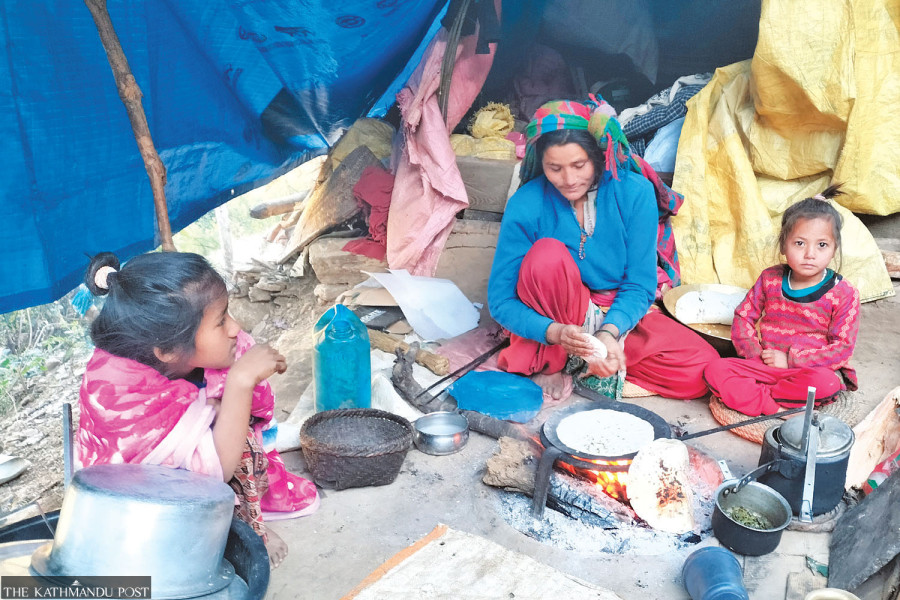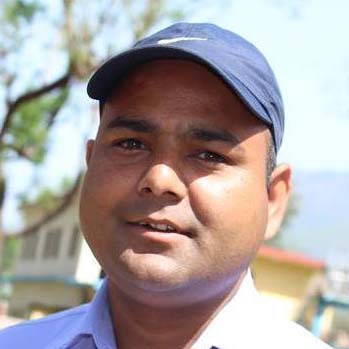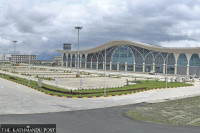National
Delay in grant distribution leaves most survivors of November 3 earthquake without secure shelters
Out of the total 35,140 households listed as eligible for a government grant in Jajarkot, only 5,203 families have built temporary shelters.
Krishna Prasad Gautam & Hariharsingh Rathaur
Fifty-two-year-old Nar Bahadur Mahar moved his family of seven from the tarpaulin tents they had been living in since the November 3 earthquake to a hut he had built using corn stalks as protection from the cold. He was hoping to make better arrangements with the grant he was to receive from the government to build a temporary shelter before the December cold set in.
But his plan has yet to materialise.
“The earthquake destroyed our stone-and-mud house and we became homeless,” said Mahar. “We lived in tents for more than a month, but now the cold is unbearable and it’s impossible to live in plastic tents. I heard that government officers are visiting the affected settlements and handing over the grant. But no one has visited us so far. Families with political connections have already received the grant and are building shelters, but our turn is yet to come.”
Balu Nepali’s nine-member family has also been languishing in a tent for the past one and a half months. He has been using old clothes to cover the tarpaulin to keep the cold out. “But it doesn’t help much because of the dew. My children are suffering so much from the cold,” said Nepali, a resident of ward 1 of Rawatgaun in Bheri Municipality. “We light a fire at night and try to stay warm.”
A total of 35,140 households have been listed in Jajarkot as eligible for receiving a grant announced by the government. But as per the data available at the district disaster management committee, temporary huts have been constructed for only 5,203 families so far. “The figure excludes the huts built by various political parties, their sister organisations and other social organisations. We have data of the temporary huts which have been built by using government grants,” said Chief District Officer of Jajarkot Suresh Sunar. He estimates that around 1,500 huts have been built by the parties, social organisations and volunteers in the district.
According to the Temporary Housing Construction Grant Procedure for Earthquake Affected Households-2023, each displaced family whose house is completely or partially damaged and has become inhabitable will receive a total of Rs50,000 in two tranches.
According to Sunar, a total of Rs 776.3 million has been released to build temporary huts in seven local units in Jajarkot. Only 6,199 families have received their first tranches as of now. He said that the grants were not issued to Nalgad Municipality and Junichade Rural Municipality due to lack of budget. Sunar admitted that around 28,400 earthquake-displaced families are still living in tents.
Dambar Bahadur Rawat, mayor of Nalgad Municipality, said that although they completed all due processes, the authorities have not yet disbursed the first instalment of the grant on time.
“The funds from the federal government have not arrived yet. Some volunteers have built temporary shelters in the municipality for the displaced while in some cases the displaced people have started making their own arrangements,” said Rawat.
Chief District Officer Sunar said that an additional Rs500 million was requested for the construction of temporary shelters for the earthquake-displaced victims from the National Disaster Risk Reduction and Management Authority. However, after 11 days of continued requests, the authority has so far sent only Rs40 million.
“The funds we have received so far are not enough to cover all the displaced families. So far, we have disbursed construction money for temporary shelters to 6,199 families in five local units of the district, at a rate of Rs25,000 per family,” said Sunar.
According to Kali Bahadur Khatri, chief of the District Coordination Committee, while the grant money has been sent to the affected local units, barring a few, by the district administration office, the local units have not been able to distribute the money to the victims.
“We have been informed that Shivalaya Rural Municipality, Chhedagad Municipality, Kushe Rural Municipality, Bheri Municipality and Barekot Rural Municipality have still not completed their data collection process. They still have not been able to identify the real victims,” said Khatri. “The harsh cold is making it increasingly difficult for the displaced families to survive. And the carelessness of the local units is exacerbating their difficulties.”
Prabhakar Sharma, principal of Suryodaya Basic School located in ward 1 of Bheri Municipality, said that while all three levels of government have been playing the blame game, the survivors are suffering.
“The earthquake occurred more than a month ago. It has become colder now. Survivors are living in inhumane conditions in this weather under a tarpaulin tent, with no warm food or clothes,” said Sharma. “People are falling sick and they are struggling to even manage two meals a day.”
According to Badri Pant, the chairman of ward 4 of Nalgad Rural Municipality, around 500 houses were completely destroyed in the ward, and so far, only 40 temporary shelters have been built.
According to the officials of the district administration offices, in Jajarkot and West Rukum, 34 earthquake-displaced victims living under tarpaulin tents have died of cold, diarrhoea, and fever, among other illnesses.
According to Hari Prasad Pant, chief district officer of West Rukum, around Rs480 million has been distributed to the victims of the district for the construction of temporary shelters. Similarly, 19,934 families received the first instalment of the grant.
“Around 5,000 temporary shelters have been built across the district using the first instalment of the grant,” said Pant. “We hope construction work will pick up pace so that every displaced family can move to a secure shelter soon.”




 8.12°C Kathmandu
8.12°C Kathmandu
















